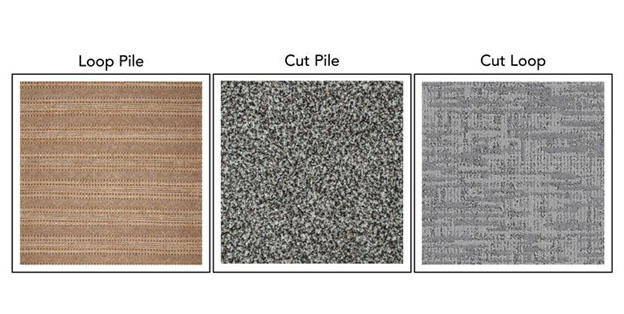If you’ve made a commitment to carpet in your home, there’s plenty to learn before sealing the deal. From basic utility to all things aesthetic, flooring plays a great role in the look and feel of a space. There are hundreds of different carpet types, and understanding the benefits of each will help you make a decision that works best for you. Before you get lost in the abyss of nylon, cut loop, and more, here’s a simple guide that won’t leave you guessing.
CARPET CONSTRUCTION
The way a carpet is constructed determines its quality and durability, two important factors to consider before making a purchase. While manufacturers will make claims of durability and quality, it’s best to instead look at how the carpet is constructed.

The three main factors of construction are:
Density: As the name suggests, density refers to how many fibers are in a pile (the actual carpet, which is attached to a backing) and how tightly packed the fibers are. As a basic rule, denser carpets are more durable.
Weight: Weight is an indicator of density, as it is measured by square foot. The higher the weight, the more fibers per square foot, and the denser and durable the carpet.
Twist: Many carpets are made using a twist technique, in which the fibers are twisted to increase durability and structure. Carpets with a higher twist per inch (TPI) will stand up to matting or flattening, making them more durable.
CARPET STYLE
The style of a carpet is determined by the way the fibers are stuck to their backing. The style influences both the aesthetics and durability of a carpet. The three main carpet styles are:

Loop Pile: Loop-pile (or Berber) carpets have fibers that are formed into little loops and then stuck to the backing. This style can be tall or short and tightly or loosely constructed, depending on the size and number of loops. Loop-pile carpeting is best for hiding dirt and very durable.
Cut Pile: Cut-pile carpets have no loops, with the frayed fibers sticking straight up. Cut-pile is typically much softer and plusher than loop-pile carpets.
Cut Loop: Cut-loop carpets are simply a mix of loop-pile and cut-pile, making them dense and durable but also soft and plush.
CARPET MATERIAL
The material of your carpet depends on the type of fiber that it’s made from. There are both synthetic and natural fibers for carpeting.
The most popular carpet materials are:
Nylon: Nylon is the most popular synthetic carpet material due to its durability and versatility. The flexibility of nylon allows the material to be used in a variety of different carpet patterns and styles, from ultra-plush to dense and tightly packed.
Acrylic: Acrylic was originally used as a wool substitute, giving you the look of wool for a lower cost. Acrylic is stain-resistant and easy to clean, fade-resistant, and water-repellent. Acrylic, however, is less durable than wool and can become fuzzy over time due to wear and tear.
Polyester: Polyester is extremely stain- and fade-resistant and less expensive than other synthetic carpet types. If you choose polyester carpeting, opt for a well-constructed option, with a higher weight and density to ensure that it holds up over time.
Olefin: Olefin, also known as polypropylene, is made through a process in which the color is actually built into the fibers, making it fully resistant to fading or discoloration. Olefin is a good option for low-traffic areas, as it is less resilient than other materials.
Wool: Wool is the most commonly used natural carpet material, with many alluring qualities that make it so popular. Wool is completely natural, super soft, flame-resistant, and great at hiding dirt. High-quality wool is elastic and durable, which makes it great for high-traffic areas.
HOW TO CHOOSE THE RIGHT CARPET
For durability: High density and weight, twist-style construction, loop pile, nylon
For softness: Medium density and weight, cut pile, wool
For stain-resistance: Acrylic, polyester, loop pile
For fade-resistance: Olefin, acrylic, polyester
For a textured look: Medium density and weight, cut loop or cut pile, wool
For a sleek look: High density and weight, twist-style construction, loop pile.



















Your Message